Homeschool Assignment Binders
As an Amazon Associate I earn from qualifying purchases. For more details, please see our disclosure policy.
I’m keeping track of this year’s lesson plans and completed work with a homeschool assignment binder. It’s how I was able to plan the whole year in advance and not worry if we skipped a day.
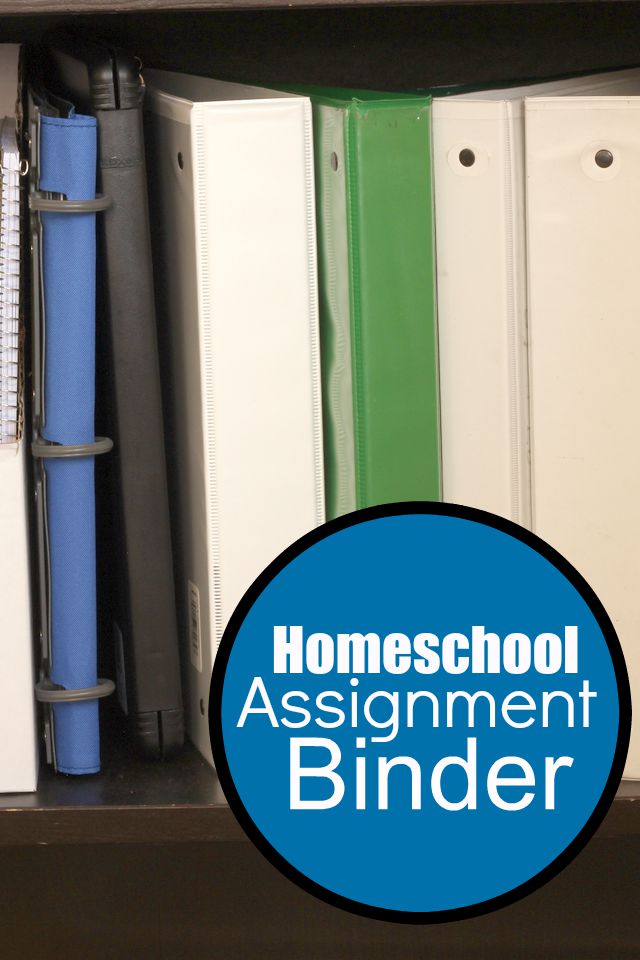
Want to save this post?
Enter your email below and get it sent straight to your inbox. Plus, I’ll send you time- and money-saving tips every week!
Homeschooling can be a great way not only for kids to learn, but also for parents to enjoy a different type of relationship with their children. Some would say for better or for worse – haha! While I don’t have to cajole my kids to find their shoes and homework every morning in order to get to school on time, I do have to make sure they actually do the schoolwork.
To be sure, there’s a different dynamic to parenting. I struggle to make sure that all the balls are in the air when they need to be. Sometimes it happens. Sometimes I mess up.
This year I’m trying a new strategy for record keeping and tracking my kids’ work: homeschool assignment binders.
As I mentioned the other day in talking about homeschool planning, I’m trying to make sure that my kids know what they’re supposed to do when they’re ready to do it. There have been too many weeks when I’ve been behind and not had my older kids’ assignments ready to go when they were ready to get going on their independent work.
My past method has been to keep one homeschool binder for everyone where I store attendance sheets and weekly lesson plans as they are completed. The lesson plan I wrote each week served as the child’s to-do list for the week. I filled it out in pencil, allowing for changes; they checked things off as they completed them.
The problem arose when I wasn’t ready bright and early on Monday morning when they were.
I tried to combat that by filling out several weeks’ worth of lists at one time. That didn’t work because we might miss a day here and there and then need to shift everything. Erasing and rewriting was such a pain — and a little defeating, too. I was never ahead.
I’m trying to mend my ways through these new homeschool assignment binders. I have no idea if they will work all year long, but I’m giving it a try. After one week, I feel like they will. It is taking the kids awhile to break the habit of looking for a weekly to do sheet, but I think that will come in time as we refine this system
Regardless, let me know what you think — and if you’ve done this method or have a better method for us to try or tweak.
Here’s my new system for homeschool assignment binders:
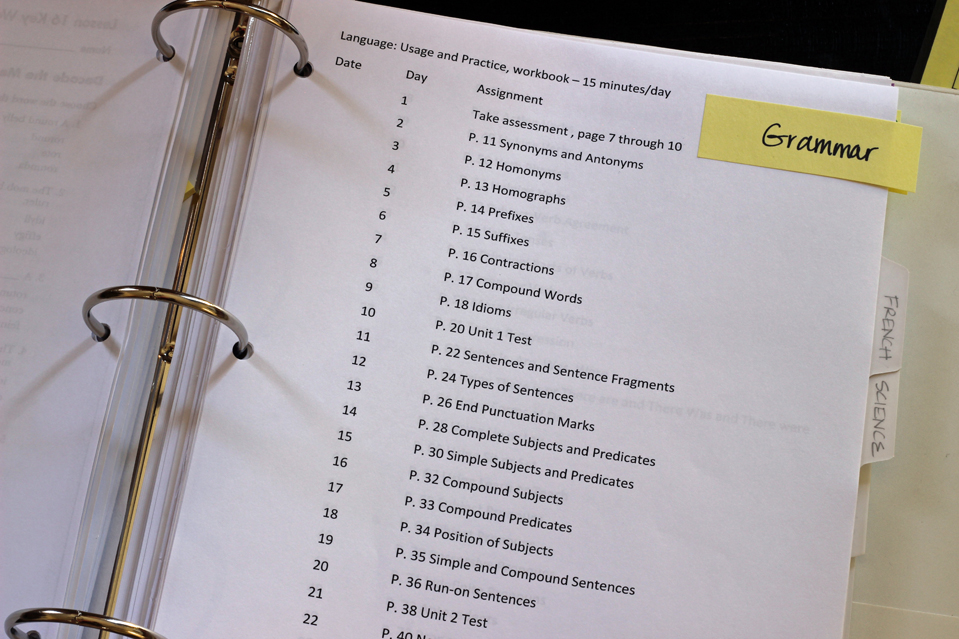
A homeschool assignment binder for each child
I’ve set up a binder for each child with dividers for every subject. I flipped through all the curriculum and lined out the whole year in a word document. I didn’t make any fancy designed form or anything like that. Depending on the subject and the book to go with, I either wrote a columned list or chart with space for writing the date completed and a check off from me.
(I now wish that I had a written lines or something so that it was clear where to check off and where to date, but I’m not printing them all out again.)
In some cases, the curriculum came with lesson plans (like the Veritas Press Omnibus) or I was able to purchase lesson plans or download them for free, prepared by moms who’ve gone before me. For instance, Apologia Science is pretty straight forward: read the module, do the experiments, complete the study guide, take the test. I had no qualms about buying those lesson plans. The $4 has saved me hours of work, mapping that all out myself.
(And apparently, buying in June will save you money. I didn’t pay the listed price a month ago!)
I also included any study aides, flash cards, or activities that my kids will do throughout the year. I’m guessing that this is normal for some people, but I used to make copies as needed — and then my kids were waiting for me to print things. I printed it all out now so they don’t have to wait for me. I even printed out all the tests!
In some instances, I bought the copies already made for me. Peace Hill Press sells packets of student pages so you don’t have to spend precious time photocopying. I decided that it was well worth the cost of paper, ink, and time.
Here are other things I’ve developed to help plan and track each homeschool assignment:
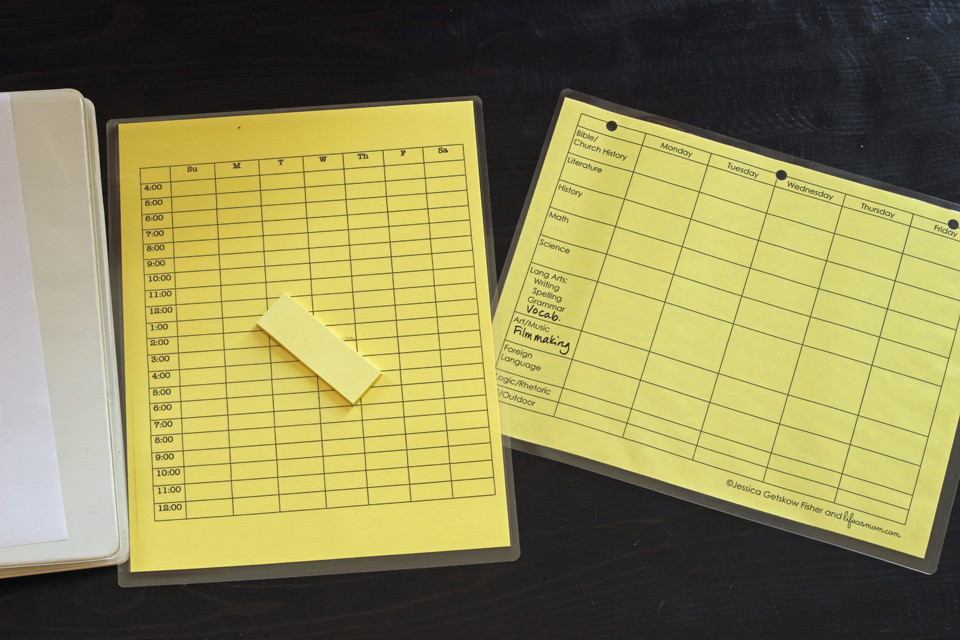
Forms available in the Print & Go Planner and the Organizing Life as MOM Homeschool Pack.
Laminated to-do list and weekly schedule
I printed a weekly to-do list as well as a weekly schedule for each kid in their color. (Every kid has had his own color since the dawn of time so that I knew whose folder or assignment sheet was whose.)
My plan was this: each week the child would fill out the things to do each day. They can do this independently or with me, depending on age and ability.
However, after this first week, I’m not sure if this will work out like I thought. It seems a little tedious for them to copy what’s already in the homeschool assignment binder.
I am sure this will take us awhile to get into the habit, but I want to equip them with strategies for time management and work control as well as let them have the freedom to figure out ways that work for them.
I added a weekly schedule/time budget so that they can see at a glance all the different things that go into the week: church, sports, doctors appointments, etc. For my teens, especially, I want them to start thinking through what they will do when so that they can manage their responsibilities themselves and not have me nag them about them.
FishBoy12 laughed when I told him the time budget was for his own personal development. “Ha! Yeah, that’s not gonna happen.”
Alrighty then. Regardless, we have fun laminated sheets if it ends up working to our benefit.
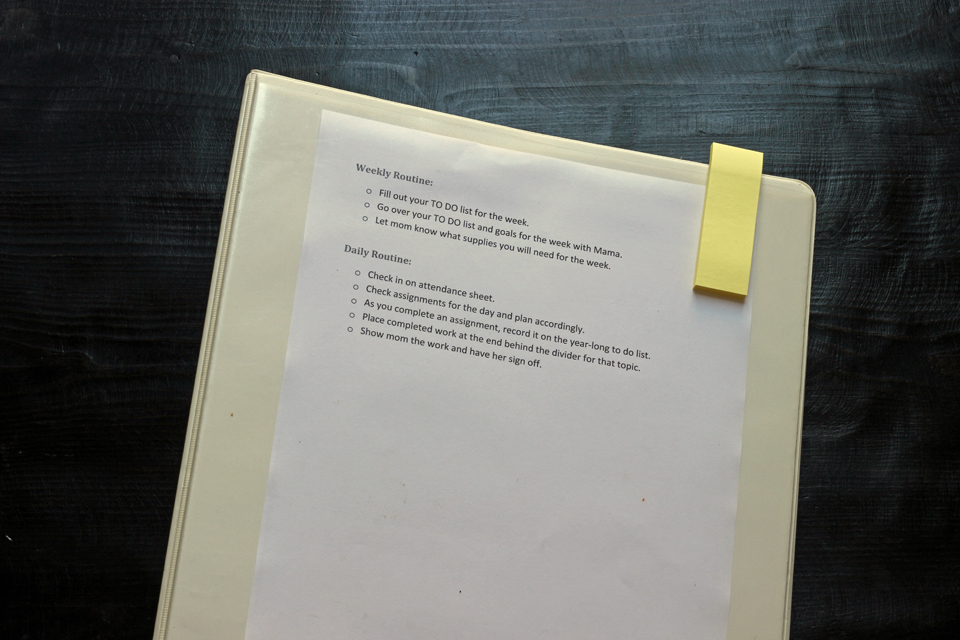
New routines
So, this new system is only as good as following through on the new routines that the system supports. This is not an automatic system that runs on its own. It’s going to require that the kids and I both make it work together, resulting in good records to document good work.
My hope, particularly for my teens, is that the kids will be learning life skills such as time management, goal setting, and working independently. I anticipate this being a process over the year, but it may be harder than I think it will be. We’ll see!
Weekly routine
Each student will need to fill out his assignment sheet for the week (the laminated one so we can reuse it) and go over it with me. He’ll also need to let me know if he needs any new supplies for projects and experiments. I might need to do this for the littles; I’m not sure yet.
Like I said, though, the jury is still out on having weekly to do sheets or not.
I’ll make sure that the assignment sheets are filled out at the beginning of the week and that completed assignments are checked off at the end of each week.
Daily routine
When an assignment is completed, the student will need to date it and check it off on the lesson plan as well as file any paper work in the binder. I’ll check at the end of each day that accomplishments were recorded and that papers were filed.
This went pretty well this first week. It took discipline on the part of EVERYONE, but we pretty much did a full week of school without too many tears.
I’m really excited about the homeschool assignment binders, especially because there’s no excuse for anyone (myself included) not to know what to do!

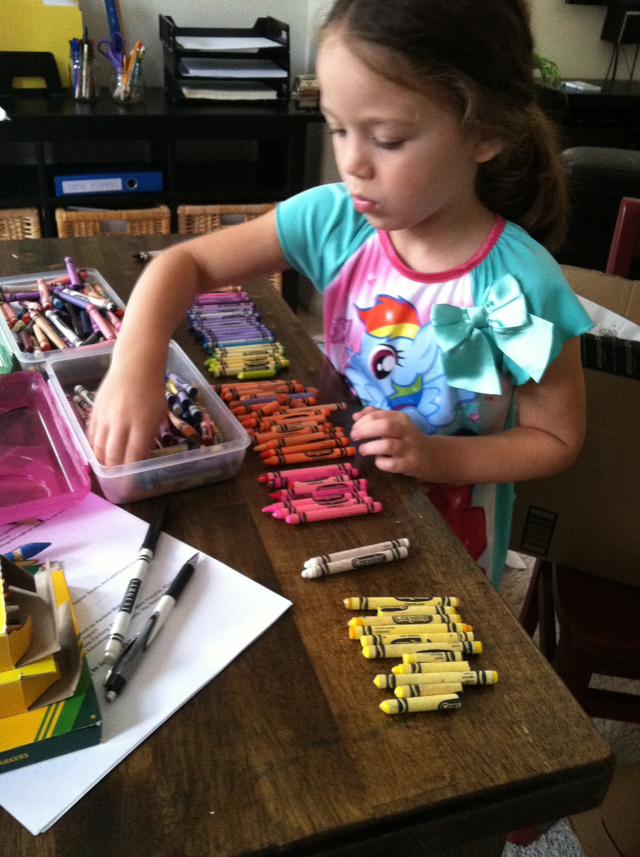
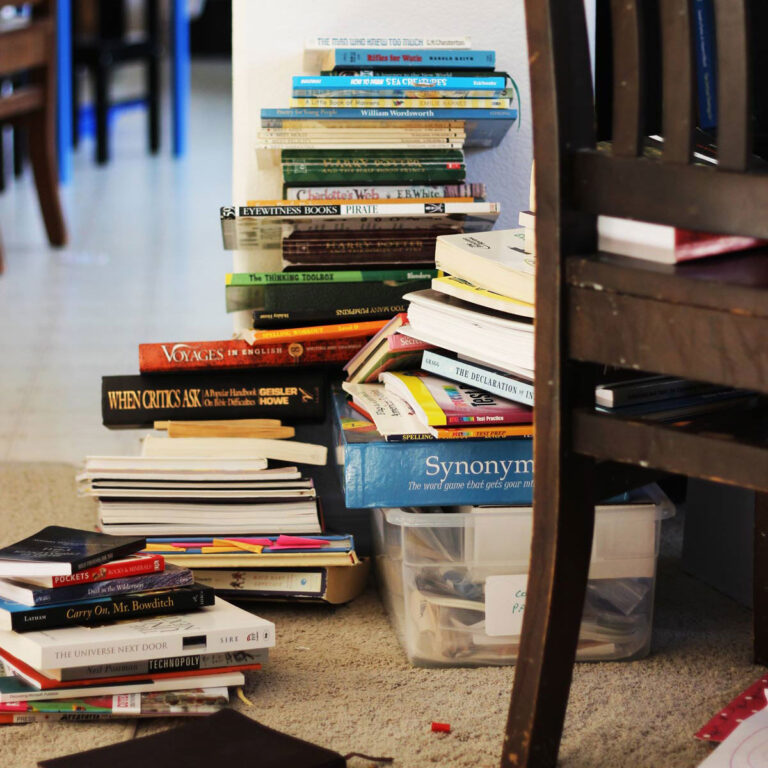


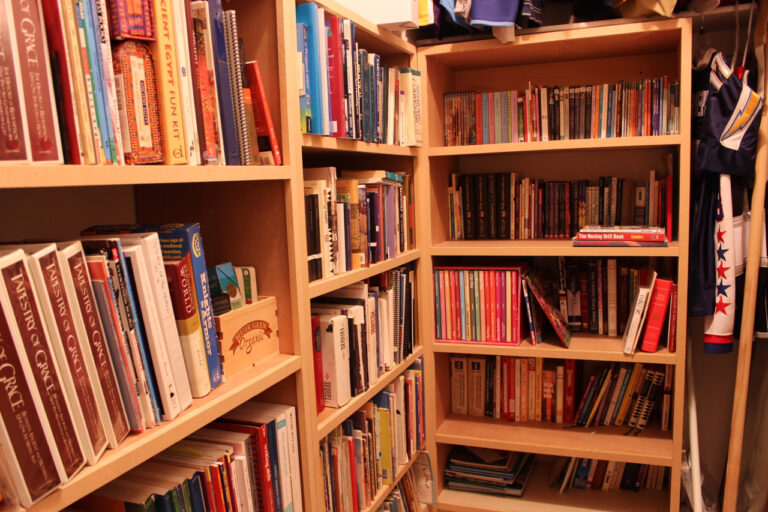

One more question…after you spent your week planning all of your kids’ school, did you just hand them, say 6 papers, one with each subject showing what they were to do, or did you reduce that to putting what they were to do for each subject each week, and keep the weekly sheets for yourself?
Thanks!
They’re placed in their binders.
How do you handle scheduling and planning when you get behind? Specifically, when you (mom!) are so behind that you didn’t realize that one kid (or more!) hadn’t done any math for the last week…or two? how do you manage to correct all the kids work and still manage everything else?
1. Remember that it happens to the best of us.
2. Just pick up where you left off and cut yourself some slack.
I don’t manage everything all the time, so I have to cut myself slack often and just keep trying.
I can’t believe I missed this one last summer! And I’m also curious to read your update. I haven’t missed that have I?!?
We do something similar to this, only with a bit more behind-the-scenes year-long planning from me (I think?). All work is divided into two kinds: Daily & Numbered. Daily is like your sheet above (except I let the book take care of the sectioning rather than me writing it out). The kids just keep plodding through each lesson (or other reasonable amount) each day. If we miss a day, no big deal; just pick it back up the next day. “Numbered” items are subjects that are more like “weekly” lessons that come out to 30-36 weeks per year (since our “year” runs for 36 weeks). Those have the entire week to be completed (like history or science), so if we miss a day, it gets bumped a day, but it gets done that week. And if things REALLY get bad, then we can do the bare minimum (like skip SOTW activities, etc.). Or heck, bump the entire week if it’s less than 36 weeks.
I plan out what is daily vs numbered and plot it all on Excel spreadsheets that are printed off every 4 weeks (because 4 weeks fit on the page), and then we just follow the charts (which get check-marks and/or stickers with completion). It’s been working great for years now. I have my days planned enough that we get the work done, but it’s not so inflexible that any hiccups throw my Type-A personality self into a tizzy. 😉
I haven’t updated the blog yet, but we are doing this same system again this year. I’ve revised the kids’ pages so they are all chart form and easier for them to check things off, date, etc. We’re still working on how best to refine their daily to-do’s. I bought everyone a kindle, so I may make their to-do lists in Evernote. Not sure, but thinking that one through now.
Jessica would love to see a how to video on this. I think I understand but would love to watch how you put this together and even how you have your binders organized. Thanks!
I will see what we can do. Thanks for the suggestion!
Yes, I was thinking the same thing, I’d love to see a video explaining it! I really like the concept.
Hi Jessica! Curious to know your thoughts now that the school year is wrapping up. What worked? What didn’t? Might make a good follow-up blog post!
I will definitely be doing it again. This month’s project is to clean out the school room so I can get planning for next year. I’ll definitely be updating this post and bringing the topic back up.
How is this method of organizing assignments going? I’m considering it for the fall and would love your input. My kids are 10, 7 ,5, 3, and 9 months, if that makes a difference.
I am definitely doing it again. Will post this summer about it.
How did I miss this post?? It’s so helpful! Thanks for sharing… I’ve been wondering if this would be worth the time to do. I’ve had similar troubles and woes with weekly assignment plans. Our first year homeschooling I had no idea how long each lesson would take. I often over-planned and the planning time felt like a waste. This year, our 2nd year, I have a better idea of how much to do in a day, but I think this method might be really good to try. It will also help me look closely all the way through each textbook to have a vision for the entire year. Thanks for your ideas, it will really help me figure out my plan.
The kids are not as up to speed with it as I am. I still need to go over it with them every day. I’m hoping it will become a habit for them. I love it!
I went to an assignment notebook when my oldest hit 8th grade and began taking outside classes and more activities that broke up our day, my kids car -schooled a lot that year because we live 1/2 hr from anywhere. The list by day worked very well for me so if we missed a day of that subject it was easy to stay organized by writing a new weekly sheet with everything on one page without turning back and forth or erasing all my plans as I had to do using a traditional planner. I created a weekly assignment sheet for each student and on fridays I would check their work and grade tests etc. As they worked more independently I was able to grade more frequently and we did a lot of oral quizzing and discussion. My oldest loved the sheets my youngest only refers to it occasionally , but they keep me on track because I plan the whole year at a time and we work till we’re done, taking breaks and holidays as needed. In the beginning we schooled year round, but since starting high school my girls like to see how soon they can finish their plan. Lately we have been finishing between the 1st and 3rd week of may after beginning in the last part of August with a few subjects and adding more each week. I also create my own planner with stuff shared on the blogs and pages I created for myself and take it to the copy store to print and spiral bind, I use laminated pages in it for saving paper on weekly or monthly lists and plans. Best wishes on a new school year.
Great. Thanks!
I used software to do much the same thing, delegating some of the older kids work to outside teachers so it was just “Latin” instead of specific lessons. Two advantages that software brought to the process were the ability to easily calculate grades and the ability to copy and paste lesson plans from one year to the next. I used grades mainly in high school.
We used expandable file folders to keep papers organized.
The curriculum we use has the related assignment pages written on the bottom of the worksheet so my kids know what to read if I am not available to get them going. We use Saxon Math and Grammar which is self-directed when I need it to be. For other lessons, I’ll put a sticky on their book and tell them what to read/do and what to do with me.
PS We use workboxes to keep subjects and papers organized.
I have done something similar for my students over the years, with varying success. I love the idea of the time budget & having the older students fill in their own assignments on the laminated sheets! It is skill I worry about. If you go to a brick & mortar school you learn to write down your assignments early on. Printing out everything they need is a HUGE time saver, even if you just schedule to do it every 8wks, or for the whole year!
I am really trying to figure out the most expedient way of getting their assignments to them, them getting the assignments done, and me checking them! Hardest part of my job!
I think I understand. Although, I’m assuming this would be an easier process with older kids who can all read and write. 🙂 Last year I did the block planning, but we haven’t gotten to the age of giving them their assignment sheets since 2/3rds can’t read and they all still do the majority of their subjects with me. My question is, how do you ensure that you are going to finish each subject by the end of the school year? Or, does that not matter?
I do like this format and planning each week based on what is happening w/out feeling like you are getting behind.
Yes, it’s more intensive for the non-reader, but even with the readers, I am needing to really program their brains to check the lists. Time will tell.
As for the pacing, I’ve got stickies all over the place telling us how often to do something, how many lessons/week, etc. We always finish one thing early and take longer on something else. With things like math, I’m doing two lessons if we skip a day, etc.